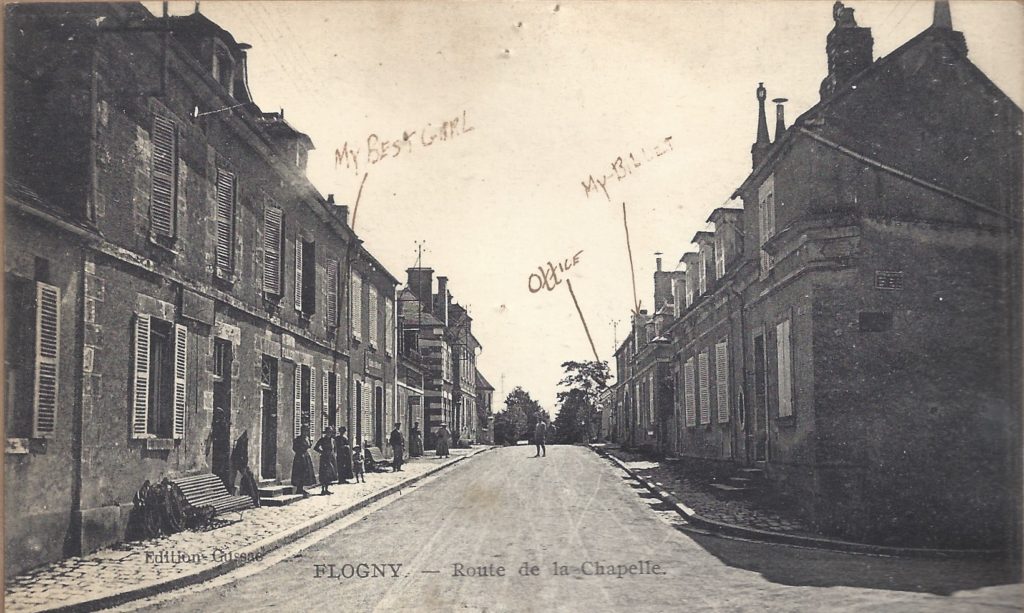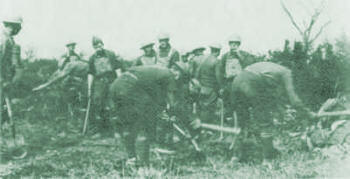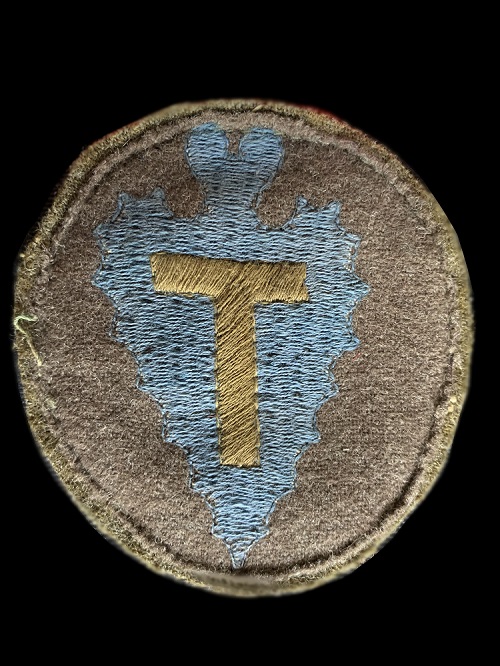
Thanksgiving Day, November 28, 1918, saw the first troops of the 36th Infantry Division arrive at their new home. The 16th Training Area in the Departement of Yonne was centered in the town of Tonnerre. There was no fort or army base, just towns and villages, a railroad, and a highway. The American Expeditionary Forces had organized twenty-one training areas behind its front line in the Meuse-Argonne area. Before and after deployment at the front, the AEF stationed its Infantry divisions in a training area nearby.
The training area around Tonnerre was a lot like the other twenty training areas. It was mostly rural, with villages separated by lots of farmland, and with very little for a soldier to do. However, when the 36th Division first arrived at the Sixteenth Training Area, there was much to do. Accommodations were subpar and winter was about to come. The whole division was put to work improving or building from scratch the basic necessities of army camp living.

Return of the Engineers
Joining the 36th Division at this time was its engineer regiment, the 111th Engineers. The 111th had just earned an enviable record as the I Corps Engineer unit, working nonstop in the only two large American offensive operations of the war. They had been in harm’s way for over sixty days, nearly three times as long as the rest of the 36th division. During that time, they’d been bombed, shelled, strafed by German planes and shot at by German machine gunners.
During combat the 111th Engineers followed closely behind front-line troops to build and repair roads for ammunition, ambulances and supplies to reach the front. In the constant rain and mud of France in autumn, it was backbreaking work. Since the Armistice on November 11th, the 111th Engineers had been marching from the front line to rejoin its division. (Read more about the 111th Engineers here and here.)

Unfortunately for the Engineers, their first order of duty was to repair all the local roads. The wet fall season meant roads were rutted and flooded. The engineers spread across the Sixteenth Training Area to restore the roads which brought food and supplies to the division. The onset of winter did not help matters, and soon infantrymen were detailed to go help the engineers. As the season wore on, the engineers opened some rock quarries for paving the roads. Soldiers of the 36th spent time away from their normal duties breaking rocks for building roads.
Home Improvement
Men of the 142nd Infantry were quartered in and around the town of Flogny-la-Chapelle. Facilities available to the soldiers varied a great deal. Living arrangements in Flogny itself were considered “excellent” by AEF standards. But some accommodations nearby were “possibly the worst found during the stay of the American Expeditionary Forces”. Although the Sixteenth Training Area had been in use since the previous spring, facilities were incomplete or missing. There were not enough beds or bathing facilities. Latrines were primitive. Sanitation was a problem. In addition, cooking facilities were outdoors and unsheltered.
Before the 36th division could fully move in, they had to make a home for themselves. Beds were moved off the ground or floor. Mess halls were built. Moreover, kitchens were enclosed or moved into buildings. Sanitation was improved and latrines were built. Most importantly, the soldiers’ beds were separated from each other using curtains or wood panels. These measures reduced the spread of disease.

Arrowheads
Around this time the AEF command ordered each division in France to submit a design for shoulder insignia. In the fifteen months of its existence, the 36th Infantry Division was known as the Panther Division, the Lone Star Division, the Tex-oma Division, and others. “Arrowhead” was probably the least associated name, but by December 1918 the Arrowhead insignia was submitted to AEF headquarters.
The design was a light blue knapped flint arrowhead, representing Oklahoma. Inside the arrowhead was a tan capital “T” for Texas. Native Americans in the 36th didn’t like to wear it because the arrowhead pointed downward, a symbol for defeat in their culture. Nevertheless, the “T-patch” has represented the 36th for one hundred years and counting.

Football comes to the AEF
In December 1918, the Southwesterners were able to spare a little time, at long last, to football. A lot of football was played back in Texas at Camp Bowie. Some road trips were organized for games at other army camps in Texas during 1917-1918. For example, with around two million U.S. servicemen now in France, the opportunities for gridiron action seemed endless. Some games within and between large units were quickly scheduled, and by the end of the month the 36th divisional team was headed to the First Army championships. That game was played in Tonnerre on New Year’s Eve, 1918. The 36th Division eleven won First Army by beating the 80th Division 20-0.
On January 19, 1919, an unofficial game near Paris pitted the 36th Division against Services of Supply-Saint Nazaire football teams. This was considered the match of the two best lines in the AEF. SOS-Saint Nazaire beat the 36th Division 12-0, but football in the AEF was far from over.
